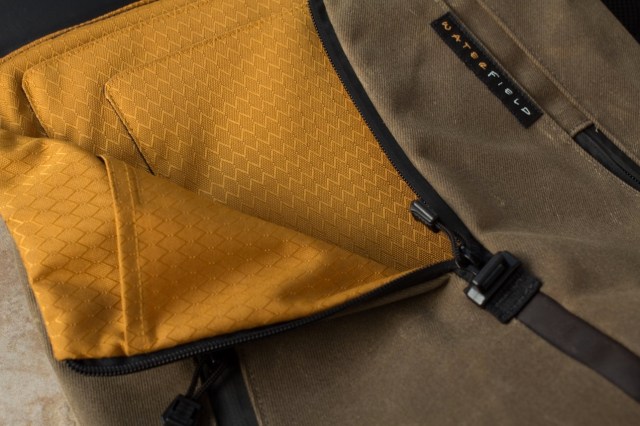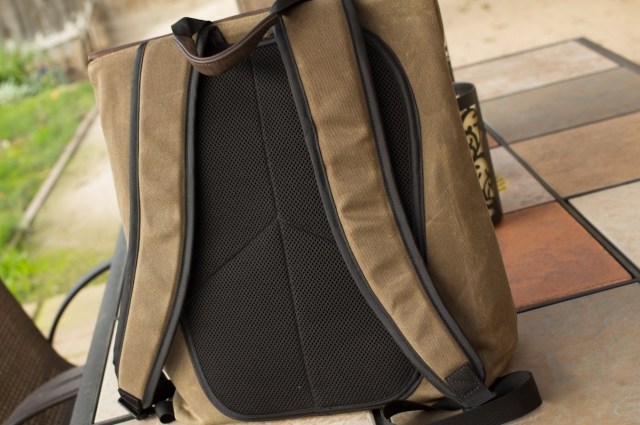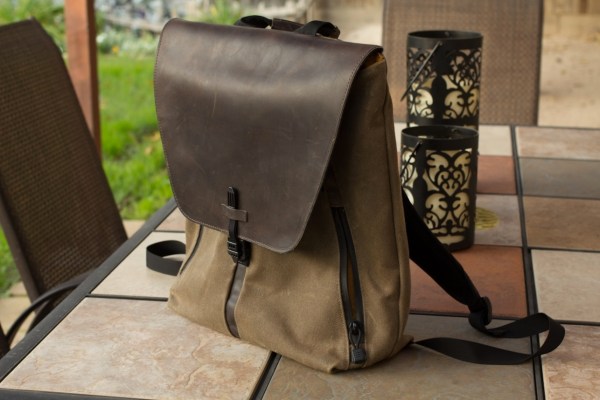There have been so many permutations of the standard backpack at this point that it’s hard for a bag maker to come up with an original spin that adds anything to the formula. WaterField, a San Francisco-based manufacturer with a reputation for quality, has done an admirable job with their new Staad bag.
The Staad is a handsome backpack with a waxed canvas or ballistic body, trademark orange WaterField lining and a large weathered leather flap in black, brown or tan. The company shipped me out both the ‘slim’ 15.5×12” and ‘stout’ 16×14.25” models to try out, but most of my impressions will be of the stout version, as that’s the one I wore out and about for a few weeks.
The stout model is set up for a 15” laptop but I used it with a 13” MacBook Air. The laptop pouch features a single side that’s softly lined, but provides a nice centrally aligned placement for good weight distribution. There’s another pouch stacked right on top of that one that fits a full-size iPad or Air quite nicely. Along with the laptop and its power adapter, it comfortable fit my Nintendo DS, a compact 4/3 Olympus camera and lens an iPad charger and other miscellaneous batteries and cords in the large main compartment.

There are only two other pockets in the interior, left and right of a unique central zipper. I used the two pockets to fit a smartphone and cable each, or a phone in one and my iPhone backup battery pack in the other. They could also be good cord keepers. I found myself wishing the back had additional interior storage, but as I’m trying to travel lighter and lighter, it wasn’t a major deal. Something to consider if you like to keep your stuff all compartmentalized though. WaterField offers a bunch of different kinds of gear and cable pouches, so one or two of those might be in order.
The pouches span the width between the zipper and the edge of the bag, and are about a hand deep. Nicely wide and not deep enough to make it hard to fish stuff out of the bottom of.

The central zipper splits the bag open like a fruit peel about half-way down the front, where it stops just above the flap clasp. I’ve never seen a backpack open quite like this. It’s interesting to get used to at first but actually makes it easier to get down into the depths of the bag without having to unpack everything from the top down. It’s also likely that this was done because the bag is narrower at the top with a wider ‘butt’ down at the bottom. There are a few interesting byproducts of this design, some more beneficial than others.

Because the bag is thin at the top and fat at the bottom, it lays very close the natural curve of your back, with the straps sewn to the top edge just behind the front flap. This makes it extremely low profile which, I’d guess, was the whole point. This is awesome when you’re ducking through crowds or trying to navigate gaps in public transportation. I found it almost never hit or got caught on stuff when I was traveling with it on my back, something I’ve always had issues with while using other backpacks, even though I didn’t carry much more with me.
However, the unique design of the bag makes it less than suited to air travel. The interior storage is distributed across the back, rather than out. This is fine when it’s on, but if you’re on a flight trying to find a place to put it, the Staad can be a bit too wide. The width is especially evident when you’re trying to find space under an obstructed seat. Most seats had enough left-to-right room, but I encountered some where either the seat supports or the configuration of the floor panels made it almost impossible to wedge the bag under there. And, on some smaller planes it was simply too wide for the overheads (though that’s a lot of bags these days).

Which brings us to the external pockets. They’re fine, on the whole. Small beaded zipper pouches that should be weather resistant, but are very easily accessible to those looking to get into them when you’re not looking. Conversely, I found it very hard to open them myself without removing the back from my back. That’s kind of a bummer when it comes to things like storing your boarding passes or Passport when traveling through airport security. I typically keep my Passport in an interior coat pocket or front pant pocket while out and about, but I like to have it in my bag for easy in-and-out along with tickets and boarding documents while I navigate security. And because the flap covers all but the front pockets, your choices are limited.
The pouches on the back of the bag do not fit a Passport at all, and if you have paper tickets, you’ll have to fold them to get them in there. so I’d love it if they were a bit longer. Not a huge deal, but something to consider if you’re a frequent air traveler. Also, it’s not TSA compliant, so you’ll have to pull your laptop out of the bag at security.
The entire bag exudes quality of craftsmanship from top to bottom, and was extremely comfortable, no matter what I had in it. The straps were wide enough and well configured for the size of the bag and the potential weight. The one construction quibble I had was that the main clasp on the front of the bag is a ‘vintage’ arrangement that feels a bit like some WWII-era bag latches, but with a plastic retaining pin. I got used to it after a while, but it’s not a standard configuration, and the plastic assembly feels a bit out of the place amongst the handsome scuffed leather and waxed canvas on the front of the bag.
The Staad is a fantastic option for a light duty backpack that should last you many years. As with most of WaterField’s stuff, it’s an investment that should pay off with a lot of years of service. The stout runs around $329, which is a bit above average but not crazy for a high quality bag that should only look better with age.
